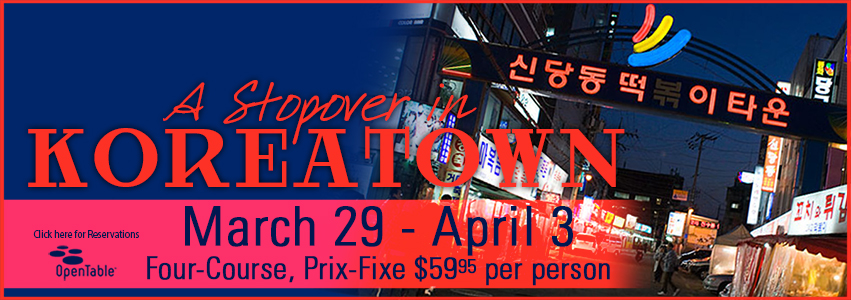
Here’s the Scoop on “A Stopover in Koreatown”
Every time I meet with Chef Alexander for insight into the next prix-fixe menu, I’m amazed at how much research, thought and ingenuity goes into creating a slate of 10 new dishes for each event. For this month’s program, however, he amps up the effort times ten.
Join us next week from March 29 to April 3 starting at 5 p.m. each evening for “A Stopover in Koreatown,” four courses with choices for $59.95++. Decline making reservations at your own peril, especially on weekends. Call 530-823-0320 or go online to www.opentable.com to carve out your preferred time.
A few caveats for the timid among you who might balk at joining us for this menu because of your unfamiliarity with the types of dishes being offered or because you fear it may be too spicy. Relax already. Everything will be delish.
Basics you need to know: Like many of our international culinary stops around the world, there are indigenous elements that are used in many dishes. Here are three that you should know about:
Kimchi: Chef Alexander’s is fermented in house (though not buried in the backyard) and it is a ubiquitous accompaniment or component deployed in Korea. Chef first brines Napa cabbage in salt water, then drains and rinses before mixing with daikon radish, green onions and a paste made from garlic, Korean chili powder, fish sauce, sugar and ginger. This mixture has two versions. . . fermented for either one or two weeks. You’re going to love this stuff.
Gochujang: A fermented chili paste used in making sauces and dressings.
Bulgogi: A marinade/sauce made from soy sauce, sugar, pear purée, sesame oil, garlic and ginger.
With these staples framing the menu, here’s what Chef Alexander is presenting:
First Course (choice of one):
Ahi Tuna Yukhoe (Pear, Quail Egg, Pine Nut, Lotus Root): Chef Alexander is riffing on beef tartare with this dish, substituting thinly diced Ahi tuna to create. . .wait for it. . .Korean Tartare. Chef tosses the Ahi with soy sauce, sesame oil, green onions and garlic and forms with a ring mold. The dish is garnished with finely diced Asian pear, pine nuts and a quail egg yolk on top. Lotus root slices are deep fried to create tasty chips for scooping up the Ahi mix.
Spring Onion Pajeon (Pancake, Kimchi, Dungeness Crab, Dipping Sauce): “Pajeon” breaks down thusly: Pa=spring onion; jeon=pancake. Chef makes the pancake with flour, rice flour, egg, chopped kimchi, juice from kimchi and spring onion. The batter is cooked in a non-stick pan, cut into wedges and topped with Dungeness crabmeat, fresh herbs and a dipping sauce made from soy sauces, sesame oil, sesame seeds garlic and rice vinegar.
“KFC” (Crispy Chicken Wings, Peanut, Korean BBQ): Get it? Korean Fried Chicken, of course. Chicken wings are dipped in a thin batter made from all-purpose flour, water and vodka. . .done twice for good measure. The wings are then tossed with peanuts and a barbeque sauce made from gochujang (see glossary). Bring on Monday Night Football.
Second Course (choice of one):
Spicy Kimchi Soup (Tofu, Beech Mushroom, Mung Bean Sprouts): Think of this as the chicken soup of Korea (a classic known as jigae). The soup’s base is created from chicken stock, kimchi, kimchi juice, ginger, garlic and for added kick, gochujang. To this, Chef adds tofu, beech mushrooms (small and white) then garnishes with herbs and bean sprouts.
Chilled Buckwheat Noodle Salad (Shaved Delta Asparagus, Perilla Leaf, Sieved Egg, Gochujang Dressing): Chilled buckwheat noodles are tossed with Delta asparagus shavings, thinly sliced red cabbage and for garnish, perilla leaf and finely chopped, cooked egg. The dressing is a thin consistency gochujang.
Main Course (choice of one):
Seafood Dolsot Bibimbap (Octopus Bulgogi, Smoked Mussels, Crispy Rice, Market Vegetables, Farm Egg): The uniqueness of this dish starts with the vessel in which it is a prepared. . .a stone bowl with lid called a dolsot, which are common in restaurants everywhere in Korean (and in Korean restaurants in America). Chef places the dolsot on a burner and covers the bottom of the vessel with cooked rice that is then crisped (source of the word bibimbap. . . “mixed rice”). Next, he arranges octopus bulgogi (see glossary), smoked mussels, veggies and pickled cucumber on top of the rice, followed by a farm egg yolk. The dolsot is presented at the table (be careful, it’s very hot!) and diners mix the components together and serve themselves.
Pork Belly Bo Ssam (Butter Lettuce Wraps, Ssmjang, Rice, Pickles): “Bo ssam” translates to pork wrap. This is a fun, assemble-your-own wrap that comes with sliced pork belly (cured in salt and sugar overnight; slow-cooked till tender; crisped in the oven; portioned and sliced) and served with butter lettuce wraps, a bowl of rice and condiments including pickles and ssamjang, a mildly spicy sauce made from fermented soy beans. . .a kind of Korean miso.
Beef Short Rib Kalbi (Black Sesame Purée, Soy-Braised Burdock Root, Charred Scallion): “Kalbi” is the Korean word for short rib. Chef strays from the traditional method of preparing short ribs by first stripping the meat from the bone and then braising in bulgogi for as long as six hours. The presentation is simple: short ribs are plated on a bed of black sesame (seed) purée and served with soy braised burdock root (common in Asia) and charred scallion.
Dessert Course (choice of one):
Korean Ice Cream Sundae (Condensed Milk Ice Cream, Sweet Adzuki Beans, Toasted Coconut, Tropical Fruit): In Korean this dish is call “patbingsu” and is made from shave ice. Chef Courtney McDonald is changing it up a bit by making ice cream from condensed milk and then creating a “sundae” with toppings sweet adzuki beans, toasted coconut and tropical fruits.
Green Tea Tapioca Pudding (Soju Strawberries, Sesame Tuile): Chef McDonald cooks tapioca in milk, sugar and green tea-infused cream. It is served with Soju strawberries, fruit that has been macerated in soju, an alcoholic beverage made in Korean. On the side are dainty cookies. . .sesame tuile.
